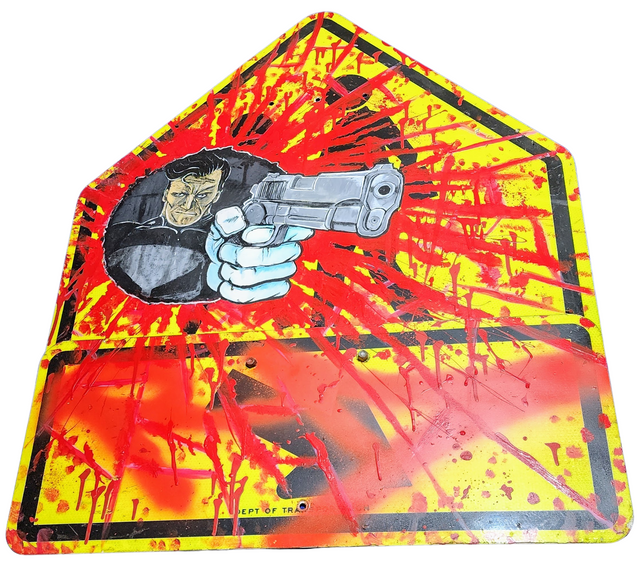
Street Signs
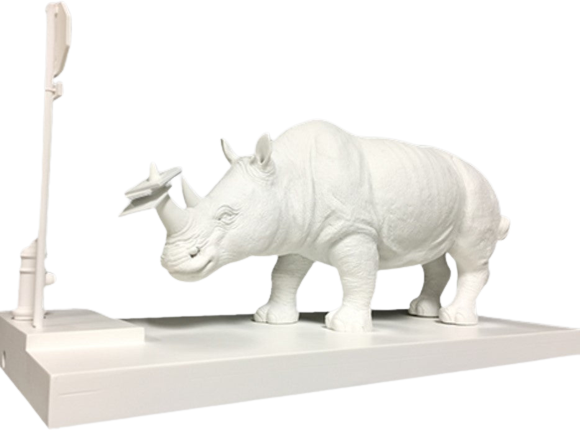
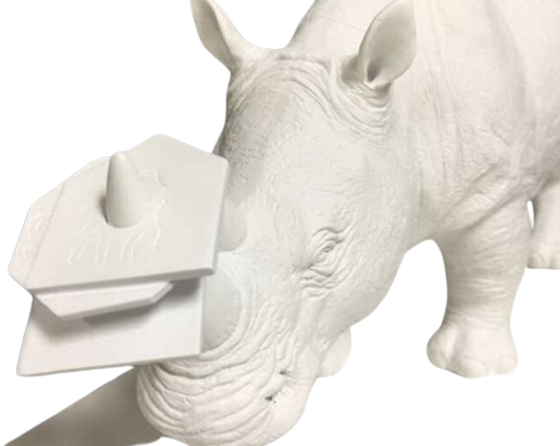
Josh Keyes The Collector Sculpture by Josh Keyes
The Collector Limited Resin Sculpture Artwork by Modern Pop Artist Josh Keyes. 2017 Limited Edition Displayed With Box The Collector - is the 3rd sculpture by Josh Keyes from our Signature Series. Once started as a beautiful painting, it has now been turned into a fully detailed sculpture with a classy Matte White finish. Sculpture Size: 18" L x 7" W x 9" H approximately Medium: Resin Josh Keyes' "The Collector" stands as a remarkable manifestation of modern pop art, embodying the fusion of street art sensibilities and acceptable art discipline. This 2017 limited edition resin sculpture is the third in Keyes' acclaimed Signature Series, which captures his work's striking visual narratives and meticulous detail. The Transition from Canvas to Sculpture Originally conceived as a painting, "The Collector" transformed into a fully realized three-dimensional form, retaining its two-dimensional predecessor's intricate detail and profound thematic elements. The transition from painting to sculpture allowed for a new interpretation of Keyes' vision, presenting it in a tangible, touchable medium. The sculpture's matte white finish enhances its sophisticated silhouette, emphasizing the clean lines and the stark contrast between the subject and its environment. The sculpture commands presence with dimensions of approximately 18 inches in length, 7 inches in width, and 9 inches in height. Cast in resin, a medium celebrated for its durability and acceptable detail capacity, "The Collector" is both a robust and delicate piece, a testament to Keyes' ability to navigate the complexities of form and substance. A Statement in Street Pop Art & Graffiti Artwork "The Collector" resonates within street pop art and graffiti artwork through its bold statement and presence. Despite its pristine finish, the piece carries the spirit of street art—challenging the observer, engaging with environmental themes, and commenting on the interaction between the natural world and human-made structures. The rhinoceros, a frequent subject in Keyes' work, is depicted alongside a street light, a juxtaposition that invites viewers to contemplate the intrusion of urban development into natural habitats. In the broader context of Josh Keyes' portfolio, "The Collector" is a signature work that showcases his concern with ecological and post-apocalyptic themes. Keyes' art often features wild animals in urban settings, exploring the boundaries between human civilization and the natural world, a theme that resonates deeply in today's ecologically conscious society. The Cultural Impact of "The Collector" As a piece of art, "The Collector" transcends mere aesthetics to engage in a cultural dialogue. It visually explores the clashes and coexistence between urban life and nature. The sculpture's stark white color serves as a canvas, highlighting the shadows and contours of the piece and allowing the form to become the central narrative. This absence of color suggests a tabula rasa, or a blank slate, inviting many interpretations from the audience. Josh Keyes' work, particularly "The Collector," aligns with the ethos of modern pop art by drawing on recognizable imagery and repurposing it within a new context. In doing so, he creates a discourse that is accessible yet laden with depth, much like the street art and graffiti that adorn the walls of cities worldwide. It is a discourse that speaks to the ubiquity of environmental change and the pervasive impact of human influence on the natural world. In conclusion, Josh Keyes' "The Collector" is a profound piece that captures the essence of contemporary issues through the lens of street pop art and graffiti artwork. Its transformation from a detailed painting to a sculptural form allows it to occupy physical space and engage with audiences directly and tactilely. Through this work, Keyes continues to challenge viewers, prompting them to reflect on the intersection of human and animal domains and the delicate balance that must be maintained between progress and preservation. The sculpture, with its limited availability, not only serves as a piece of art but also as a collectible item that mirrors our society's current ecological and cultural challenges.
$400.00
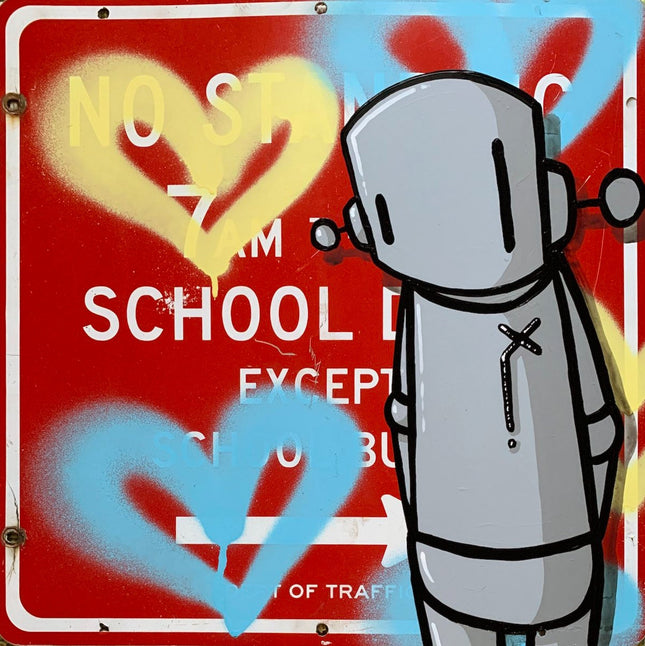
Chris RWK- Robots Will Kill Stand Alone Original Street Sign Painting by Chris RWK
Stand Alone Original Mixed Media Painting Graffiti Artist Modern Pop Art on Real Metal Street Sign by Chris RWK. 2022 Signed Original Mixed Media Acrylic & Spray Paint on Real 18x18 School Zone Street Sign. Chris RWK's Stand Alone: A New Dimension of Street Sign Art In the vibrant landscape of modern pop art and graffiti artwork, Chris RWK (real name Chris Roberts), an artist from New York, presents a compelling twist on the genre with his creation "Stand Alone." This piece, a signed original mixed media painting completed in 2022, defies conventional street art norms by utilizing an actual 18x18 school zone street sign as its canvas. The artwork's foundation in the natural and practical – a metal sign designed to impart rules – becomes a statement of artistic rebellion and creative liberation. The Fusion of Mediums in Chris RWK's Work "Stand Alone" is an innovative meld of acrylic and spray paint, mediums that have long been staples in the street artist's toolkit. By applying them to a metal street sign, Chris RWK bridges the gap between the everyday street objects we often overlook and the expressive potential they hold. His robot-like character, a recurring motif in his work, is depicted with a simplicity that speaks to childhood innocence, juxtaposed against the backdrop of an adult world filled with regulations and restrictions. The duality of this piece – the playful imagery against the stern, directive nature of a street sign – invites contemplation on the push and pull between the structured world we navigate and the imaginative freedom we often yearn for. This tension is at the heart of street pop art, where the mundane is transformed into the extraordinary. Embracing the Ordinary: The Iconography of Chris RWK In "Stand Alone," the ordinary is embraced and celebrated. Chris RWK elevates an ordinary street sign to a piece of art that can communicate complex emotions and ideas. The robot figure, often interpreted as a stand-in for the human experience, is portrayed alongside a heart symbol – a universal expression of love and connection. This simple yet profound imagery speaks to the artist's ability to find depth in simplicity, a hallmark of his broader body of work. The use of real-world objects in art is not new, but Chris RWK recontextualizes this approach within the framework of street pop art, inviting the viewer to see the potential for art in all things. Once a directive object, the street sign becomes a canvas for reflection, a medium through which the artist can connect with the audience on a personal level. Chris RWK's "Stand Alone" is a standout piece within the domain of graffiti artwork and modern pop art. It captures the essence of street art's transformative power, turning a mundane object into a source of artistic expression and commentary. As viewers encounter this piece, they are reminded that art is not confined to galleries or murals on building walls – it can emerge from the most unexpected places, offering new perspectives on the familiar fixtures of our everyday lives.
$2,500.00
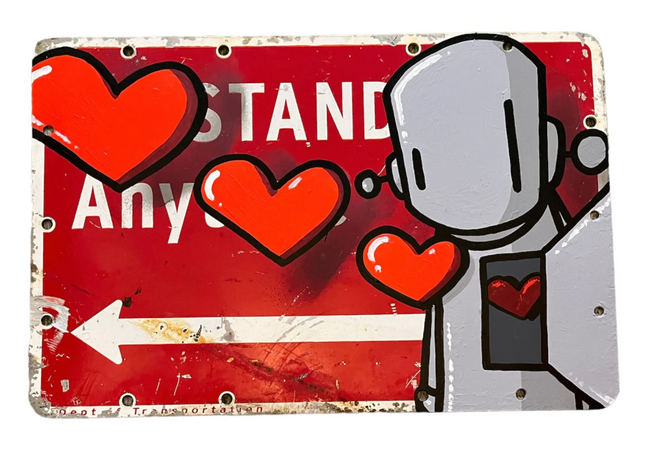
Chris RWK- Robots Will Kill Keep Moving Original Street Sign Spray Painting by Chris RWK- Robots Will Kill
Keep Moving Original Street Sign Spray Painting by Chris RWK- Robots Will Kill Mixed Media Modern Graffiti Paint Pop Art on Real Metal Ready To Hang. 2023 Signed Original Mixed Media Spray Paint Acrylic Painting on Reclaimed No Standing Anytime Metal City Sign Size 18x12 Innovation in Reclaimed Art by Chris RWK "Keep Moving" by Chris RWK, from the collective Robots Will Kill, stands as a testament to the transformative power of street art, taking an object as valid as a 'No Standing Anytime' metal city sign and repurposing it into a canvas for modern graffiti paint pop art. Created in 2023, this signed original mixed media spray paint and acrylic painting is a ready-to-hang piece that measures 18x12 inches, embodying the ethos of Street Pop Art and graffiti Artwork. Chris RWK's work is renowned for its ability to communicate complex emotions and societal narratives through street signs' deceptively simple visual language. By reclaiming and repurposing a metal city sign, he not only recycles the physical material but also reclaims the cultural and communicative space these signs occupy. The robot character, a recurring motif in Chris RWK's work, is depicted holding hearts—a sharp contrast to street signage's typically authoritative and impersonal nature. Cultural Commentary on Street Pop Art The piece is a cultural commentary, leveraging the ubiquitous nature of street signs to challenge viewers to reconsider their significance and meaning. By integrating heartfelt imagery on a sign that typically denotes restriction, Chris RWK flips the script, offering a narrative of movement and emotion where one would not expect it. This act of artistic rebellion is characteristic of the graffiti movement, which often seeks to interrupt the urban landscape with unexpected messages and visuals. Chris RWK's "Keep Moving" technique showcases the artist's skill with spray paint and acrylic, using these mediums to add depth and texture to the work. The choice of a metal sign as the substrate adds an industrial edge to the painting, grounding it firmly in the street art tradition and elevating it into a piece of pop art that can be appreciated in various settings. Impact and Significance in the Art World The significance of "Keep Moving" within the art world is multifaceted. It is a piece that blurs the boundaries between high art and street art, between vandalism and sanctioned creative expression. Chris RWK's work is part of a broader movement that sees street artists gaining recognition within the fine art world, with their works increasingly sought after by collectors and enthusiasts. "Keep Moving" is a striking piece of art and a reminder of the enduring influence of street art and its capacity to challenge and redefine the spaces it occupies. Chris RWK, through his work with Robots Will Kill, continues to push the envelope, creating pieces that are at once accessible and profound, simple in their execution but complex in their implications. This painting is a vibrant example of the power of Street Pop Art and graffiti Artwork to captivate and engage audiences, encouraging them to see the urban environment through a new lens.
$1,744.00
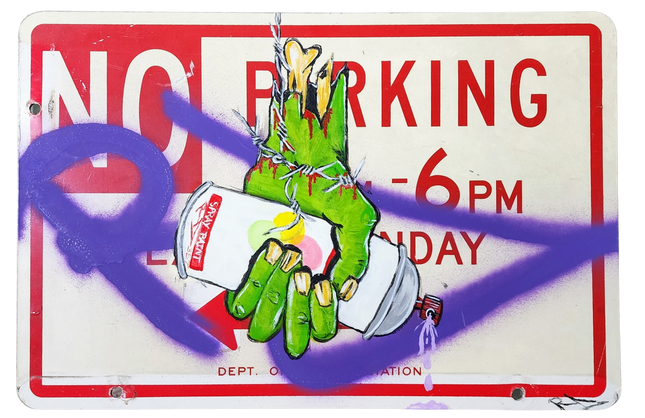
RD-357 Real Deal Zombie Hand Tag Original Street Sign Painting by RD-357 Real Deal
Zombie Hand Tag Original Street Sign Painting by RD-357 Real Deal Spray Paint Mixed Media One of a Kind of Artwork on New York City No Parking Notice Sign Pop Graffiti Street Art Artwork. 2014 Signed Spray Painting Original Artwork on Real NYC Reclaimed No Parking Metal Urban City Street Sign Size 18x12 of a Decapitated Zombie Hand Grasping & Spraying a Can of Krylon Spray Paint with the RD Tag in Purple. RD-357's Vivid Depiction of Urban Rebellion: The Zombie Hand Tag The 'Zombie Hand Tag' original street sign painting by RD-357, also known as Real Deal, is a provocative piece of street pop art and graffiti that embodies the rebellious spirit of urban street culture. Completed in 2014, this artwork uses a New York City 'No Parking' metal sign as its canvas, transforming a mundane object of urban regulation into a striking visual statement. The depiction of a decapitated zombie hand grasping and actively using a can of Krylon spray paint infuses the piece with a sense of post-apocalyptic creativity and survival. Interpreting the Symbolism in RD-357's Art This piece is rich with symbolism that resonates with the ethos of graffiti and street pop art. The zombie hand, often a symbol of horror and the macabre, is presented here as a vessel of artistic creation, subverting its usual connotations of death and decay. By wielding a can of Krylon, the hand breathes life into an art form that thrives on the fringes of society. The RD tag in purple spray paint marks the artist's signature and serves as an act of claiming territory, a fundamental aspect of graffiti culture. The choice of a 'No Parking' sign as the medium is deliberate and insightful. It represents the restrictions and boundaries imposed by society, which street art often aims to transgress. The act of a zombie hand, a symbol of defiance against mortality, spraying over such a sign is a metaphor for the resilience of street art. It refuses to be confined or controlled, much like the undead refusing to remain in the grave. The Aesthetics and Technique in RD-357's Zombie Hand Tag RD-357's technique in creating this piece highlights street art's raw and unapologetic beauty. The artwork, measuring 18x12 inches, showcases the artist's skill in manipulating spray paint, a medium often dismissed by the traditional art world but revered in street culture. The dripping paint from the Krylon can, the textured portrayal of the zombie flesh, and the striking contrast between the hand and the sterile sign it occupies all contribute to a composition that is as much a visual triumph as a statement piece. The use of mixed media, incorporating both the physical sign and the spray paint, reflects the layered nature of street art. It is both an object and a message, a tangible piece of the city's fabric and a commentary. The artwork challenges viewers to see beyond the surface to understand the depth and complexity of the messages conveyed through this unique artistic expression. Conclusion: The Cultural Impact of RD-357's Work The 'Zombie Hand Tag' is a potent example of how street pop art and graffiti can alter perceptions and engage with viewers on a visceral level. RD-357's work demonstrates street art's transformative power, which can turn a simple traffic sign into a thought-provoking piece that questions authority and celebrates the irrepressible nature of human creativity, even in the face of societal collapse. RD-357, whose real name and country of origin remain unknown, much like the enigmatic nature of street art itself, has created a piece that stands as a testament to the enduring spirit of street pop art and graffiti. The 'Zombie Hand Tag' is a visual spectacle and a narrative of resistance, a declaration that even in a world overrun by the metaphorical zombies of conformity and control, the artist's spirit remains unvanquished.
$600.00






